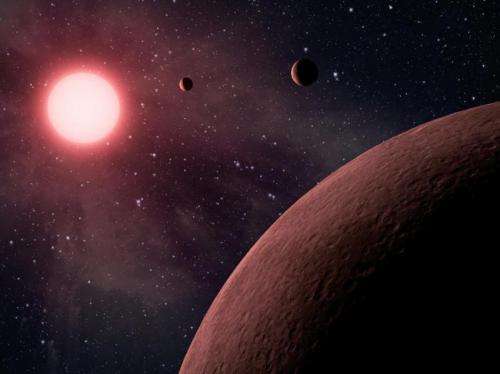July 28, 2017 report
Possible first sighting of an exomoon

(Phys.org)—A team led by David Kipping of Columbia University has spotted what might be the first evidence of an exomoon. They have written a paper describing their findings and have uploaded it to the arXiv preprint server.
An exomoon is a moon orbiting an exoplanet. Many moons have been found in our solar system and many planets outside of it, but to date, no one has captured evidence of a moon orbiting one of those exoplanets. This might change, as the team studying data from the Kepler Space Telescope believe they have found strong evidence for a moon orbiting a planet which is itself orbiting a star called Kepler-1625.
Exoplanets are found by noting the dimming of stars that occurs as a planet passes between Earth and the star. A moon would be found in roughly the same way, the researchers note, by looking for dimming that occurs in the light reflected from a planet caused by the transit of a moon. Kipping and his team report that they recorded three such dippings as the planet made three trips around its star. They have given their find a statistical confidence of slightly above 4 sigma, noting that the dipping they observed could be chalked up to a fluke in the data—there also exists the possibility that the dimming has another cause. They note that the star system is approximately 4000 light years away, which means the light from the planet is extremely dim to begin with.
The team expects their finding to be verified (or quashed) by data from the Hubble Space Telescope, which offers much better data, sometime in the near future. But while they wait, they are already developing theories about the exomoon—if it truly exists, it would have to be much larger than our moon in order to detect it, perhaps as large as Neptune. That would mean the planet it is orbiting wis also quite large, likely as large as Jupiter. If that is the case, its size suggests that it would likely have formed later than moons in our solar system. It would also make the first observed exomoon the largest moon ever observed.
More information: HEK VI: On the Dearth of Galilean Analogs in Kepler and the Exomoon Candidate Kepler-1625b I, arXiv:1707.08563 [astro-ph.EP] arxiv.org/abs/1707.08563
Abstract
Exomoons represent an outstanding challenge in modern astronomy, with the potential to provide rich insights into planet formation theory and habitability. In this work, we stack the phase-folded transits of 284 viable moon hosting Kepler planetary candidates, in order to search for satellites. These planets range from Earth-to-Jupiter sized and from ~0.1 to 1.0 AU in separation - so-called "warm" planets. Our data processing includes two-pass harmonic detrending, transit timing variations, model selection and careful data quality vetting to produce a grand light curve with a r.m.s. of 5.1 ppm. We find that the occurrence rate of Galilean-analog moon systems can be constrained to be η<0.38 to 95% confidence for the 284 KOIs considered, with a 68.3% confidence interval of η=0.16+0.13−0.10. A single-moon model of variable size and separation locates a slight preference for a population of Super-Ios, ~0.5 R_Earth moons orbiting at 5-10 planetary radii. However, we stress that the low Bayes factor of just 2 in this region means it should be treated as no more than a hint at this time. Splitting our data into various physically-motivated subsets reveals no strong signal. The dearth of Galilean-analogs around warm planets places the first strong constraint on exomoon formation models to date. Finally, we report evidence for an exomoon candidate Kepler-1625b I, which we briefly describe ahead of scheduled observations of the target with the Hubble Space Telescope.
Journal information: arXiv
© 2017 Phys.org














.jpg)






